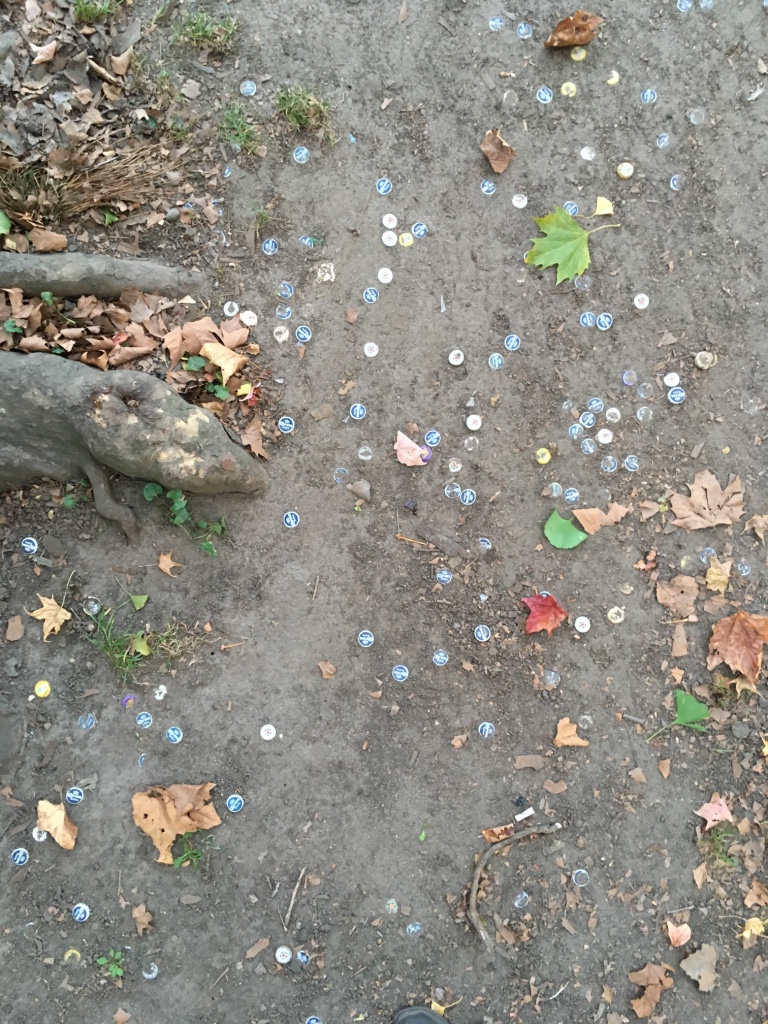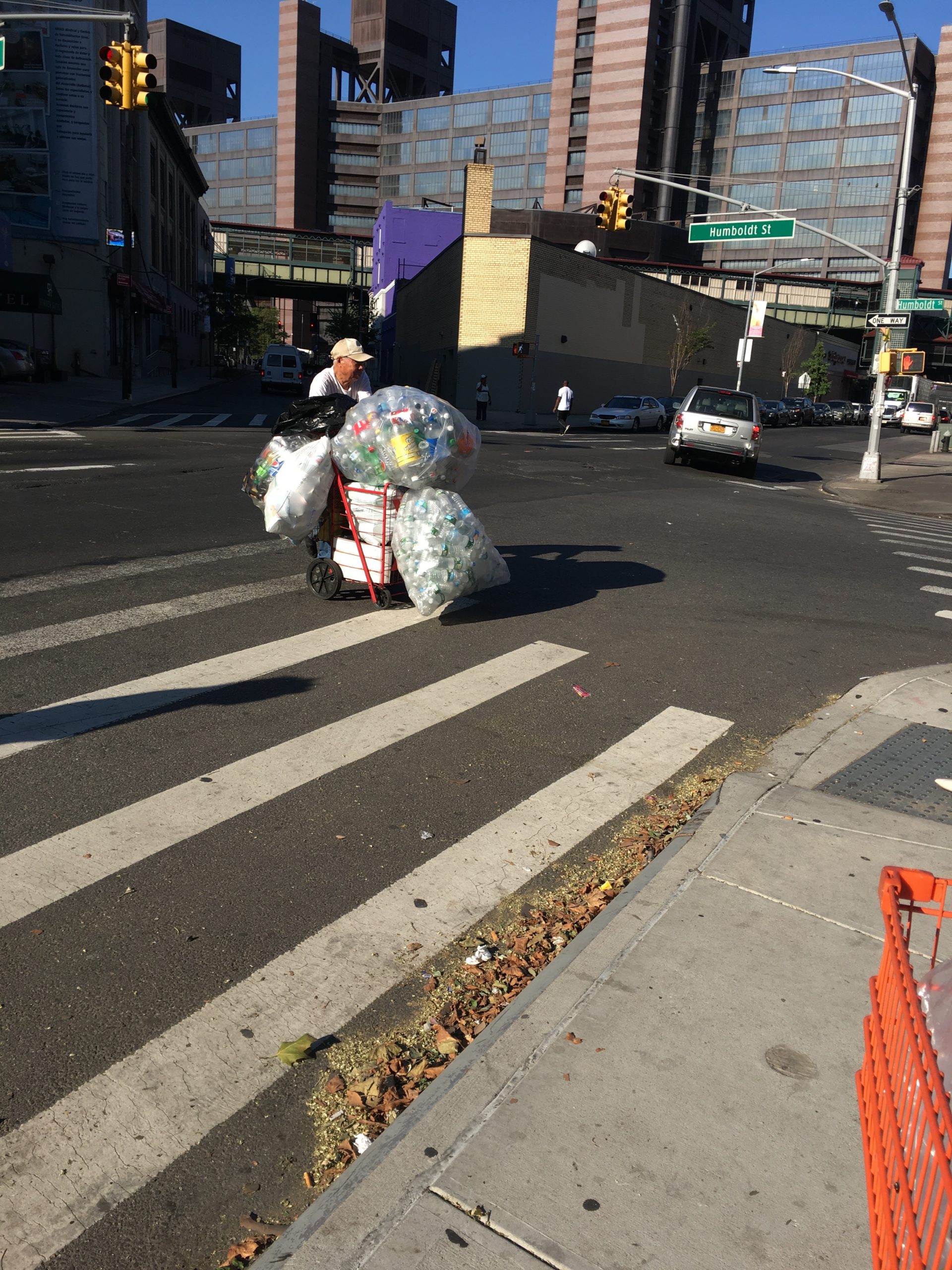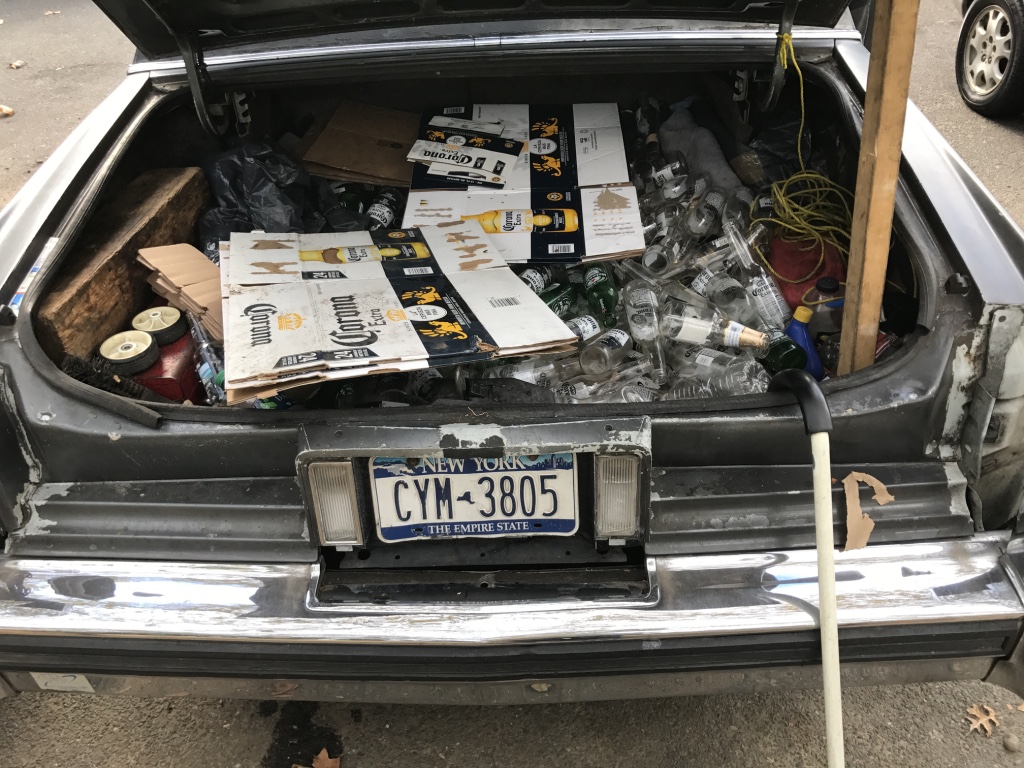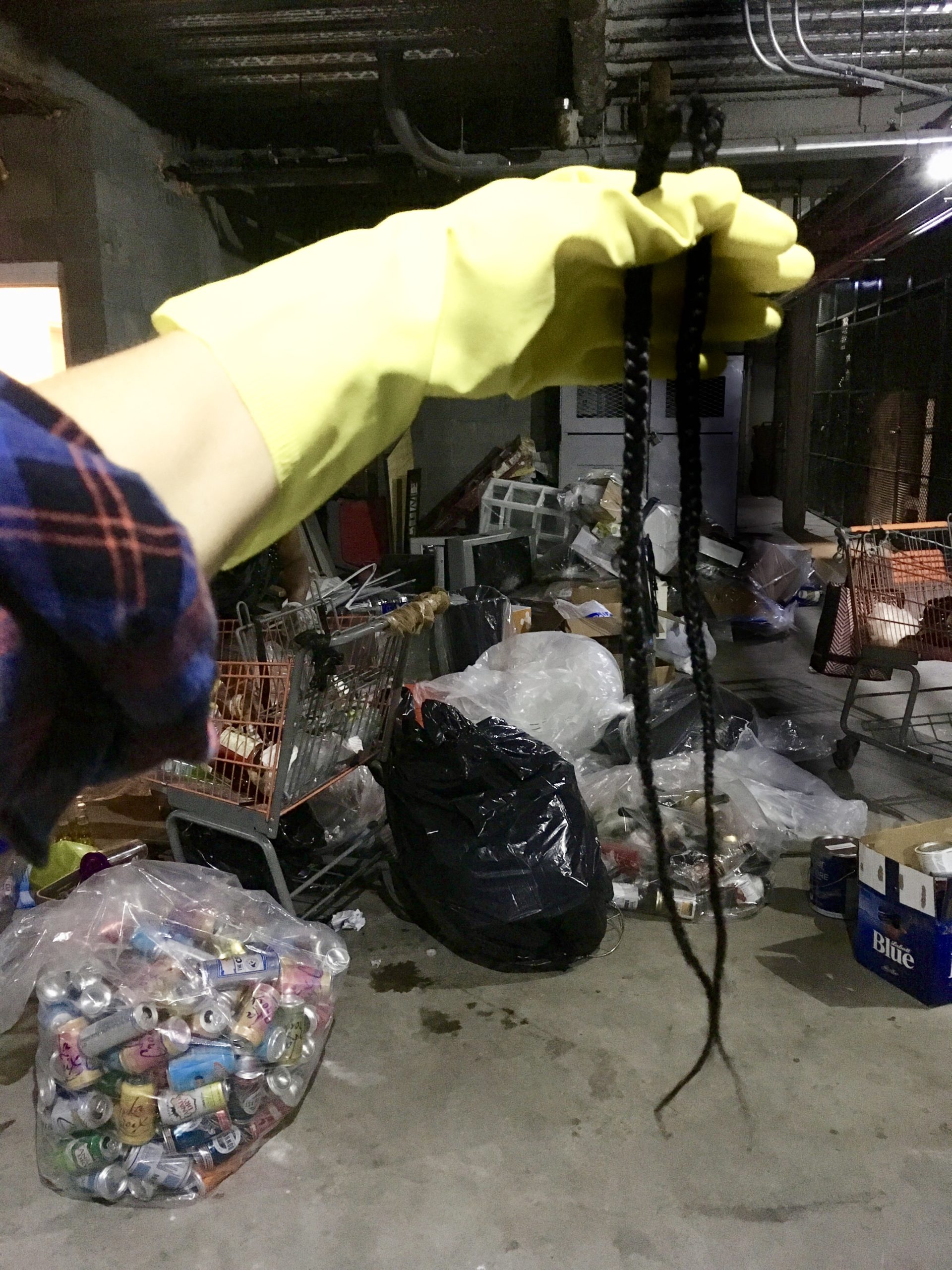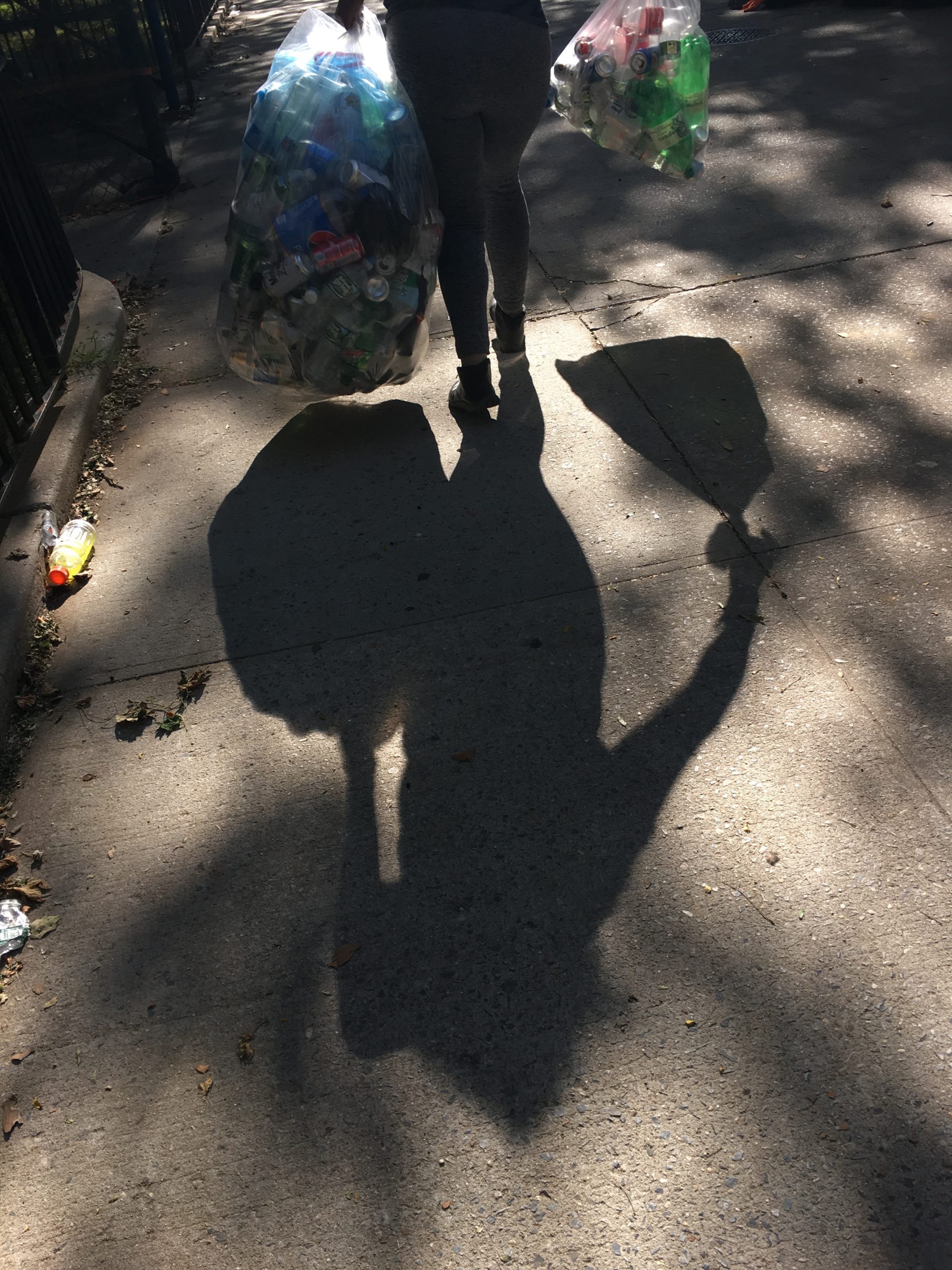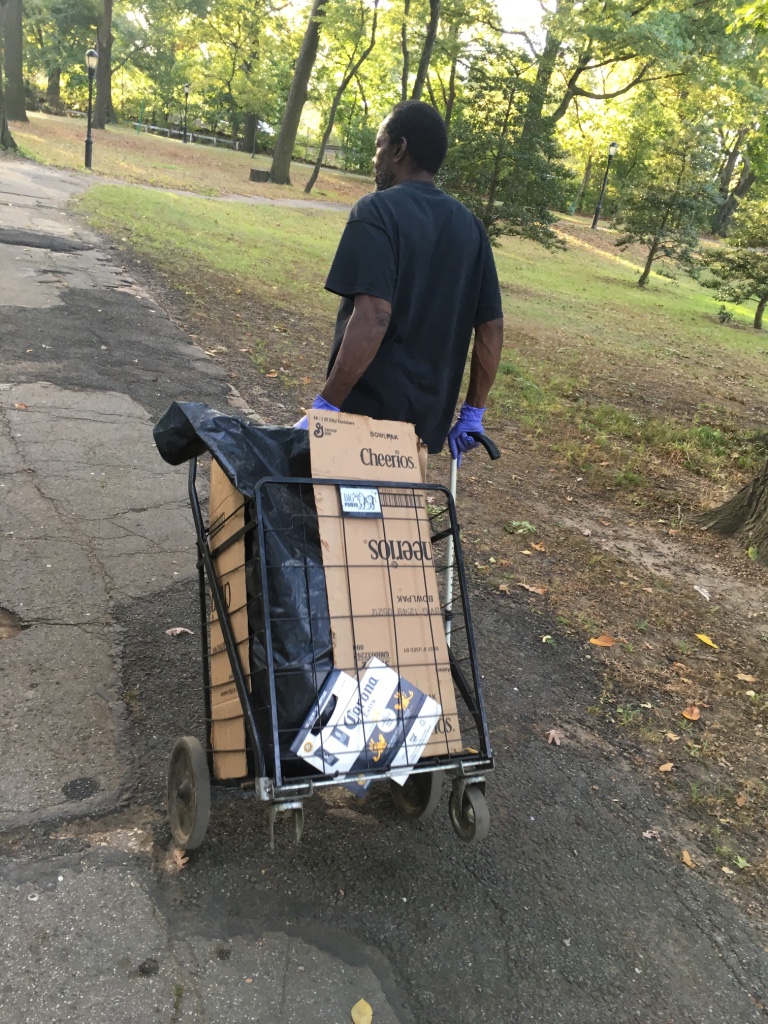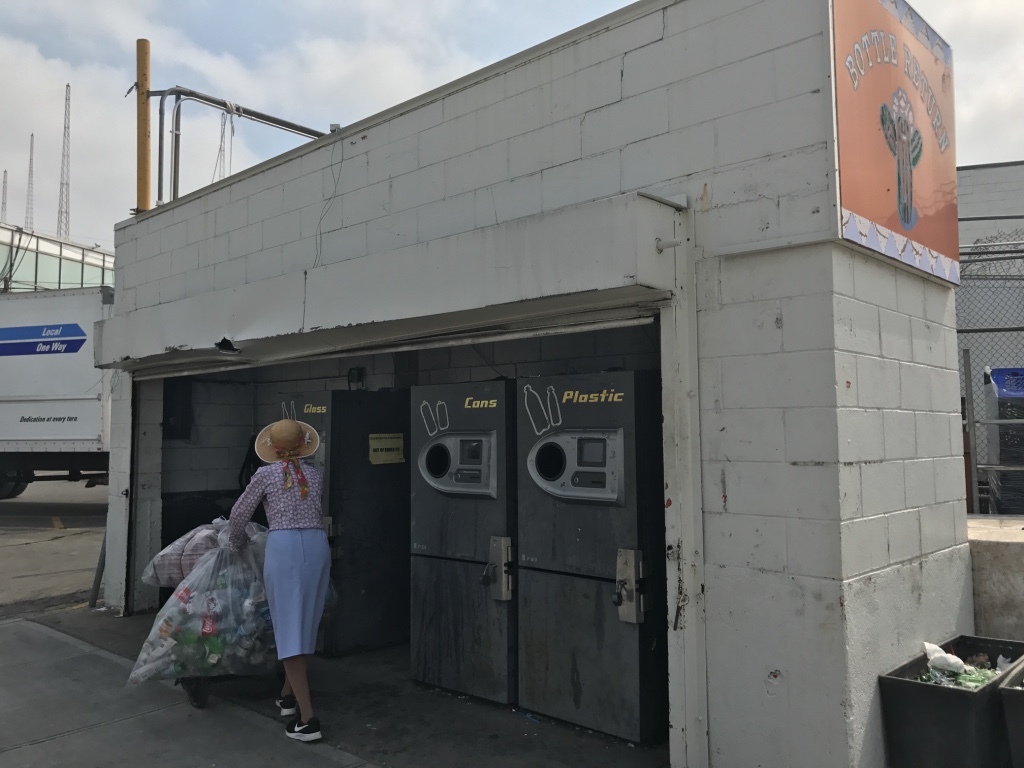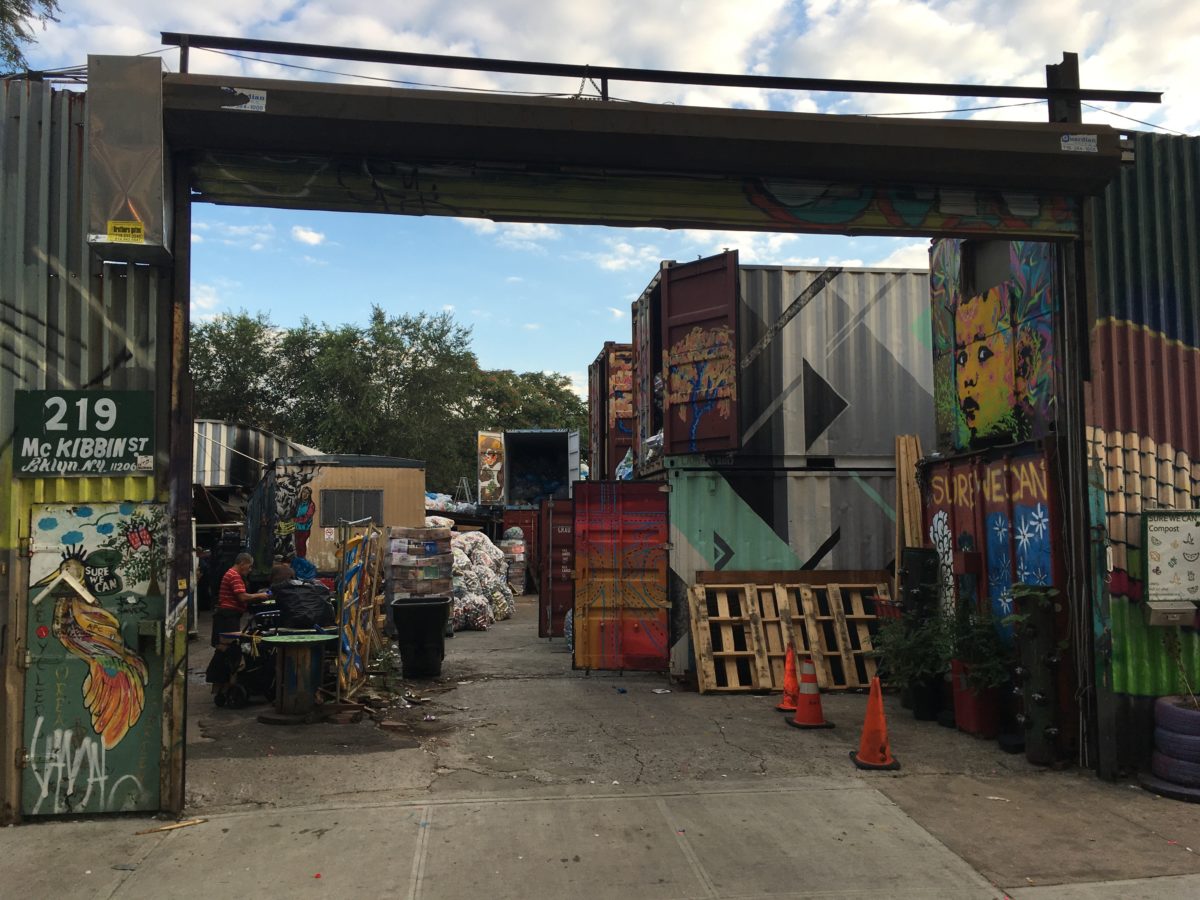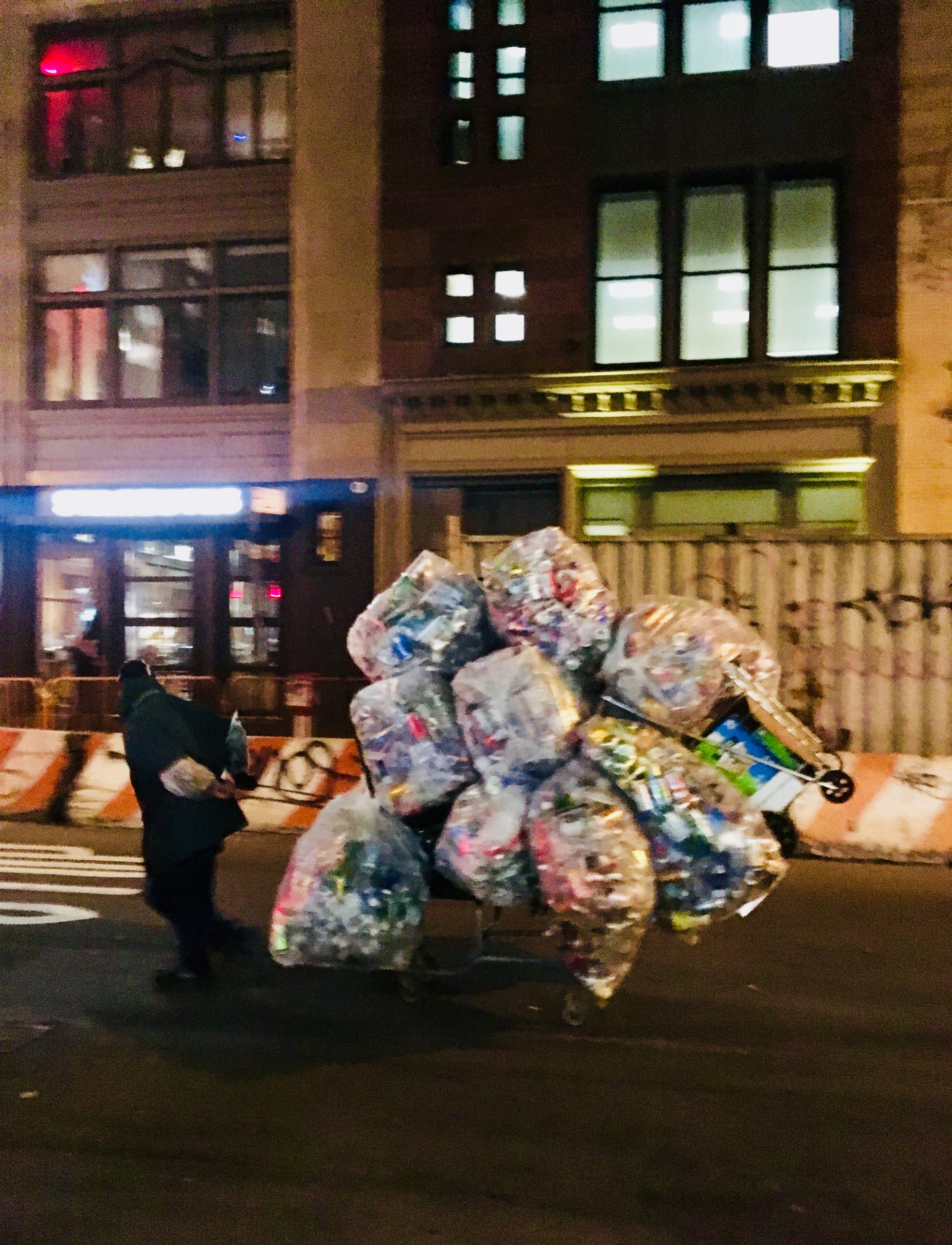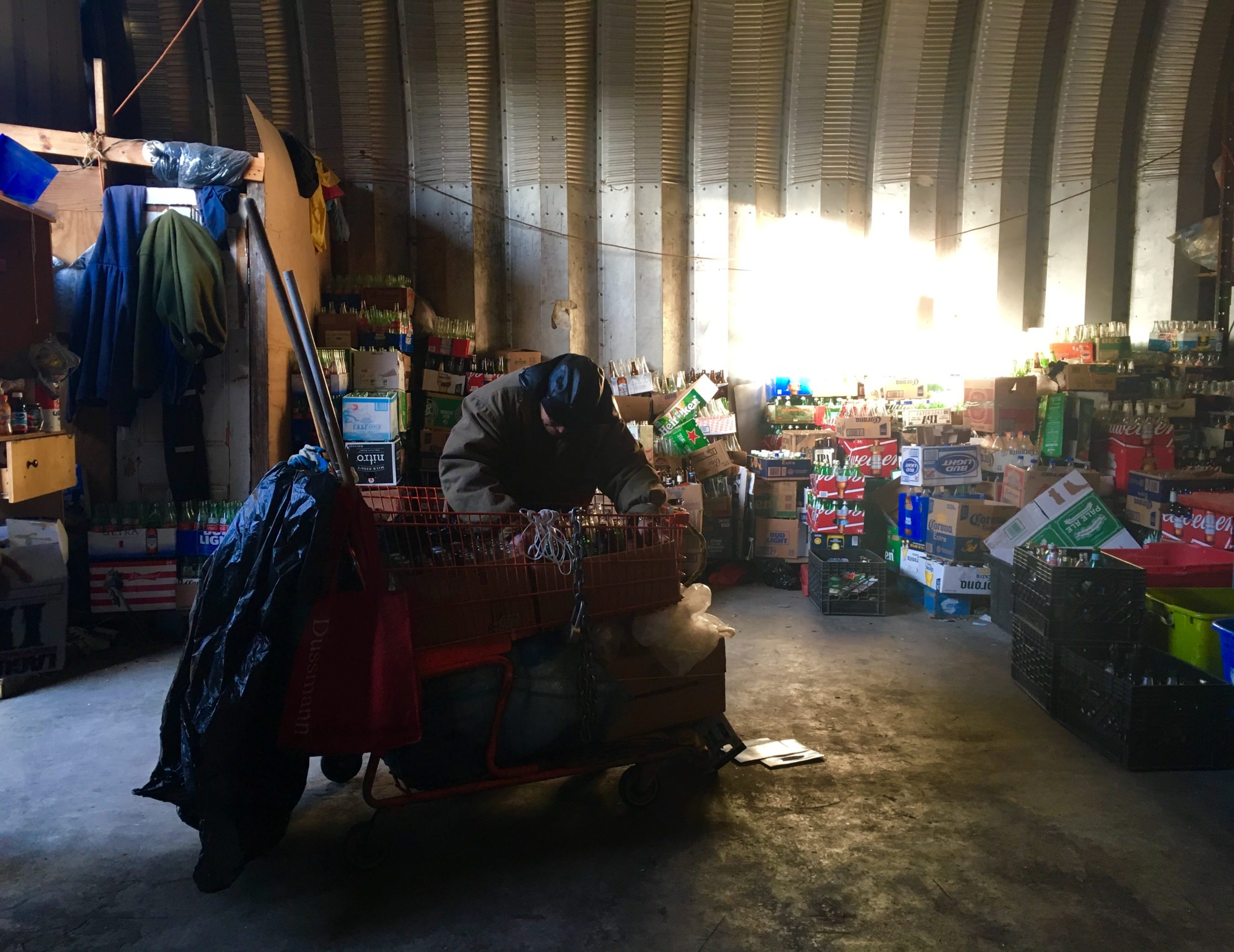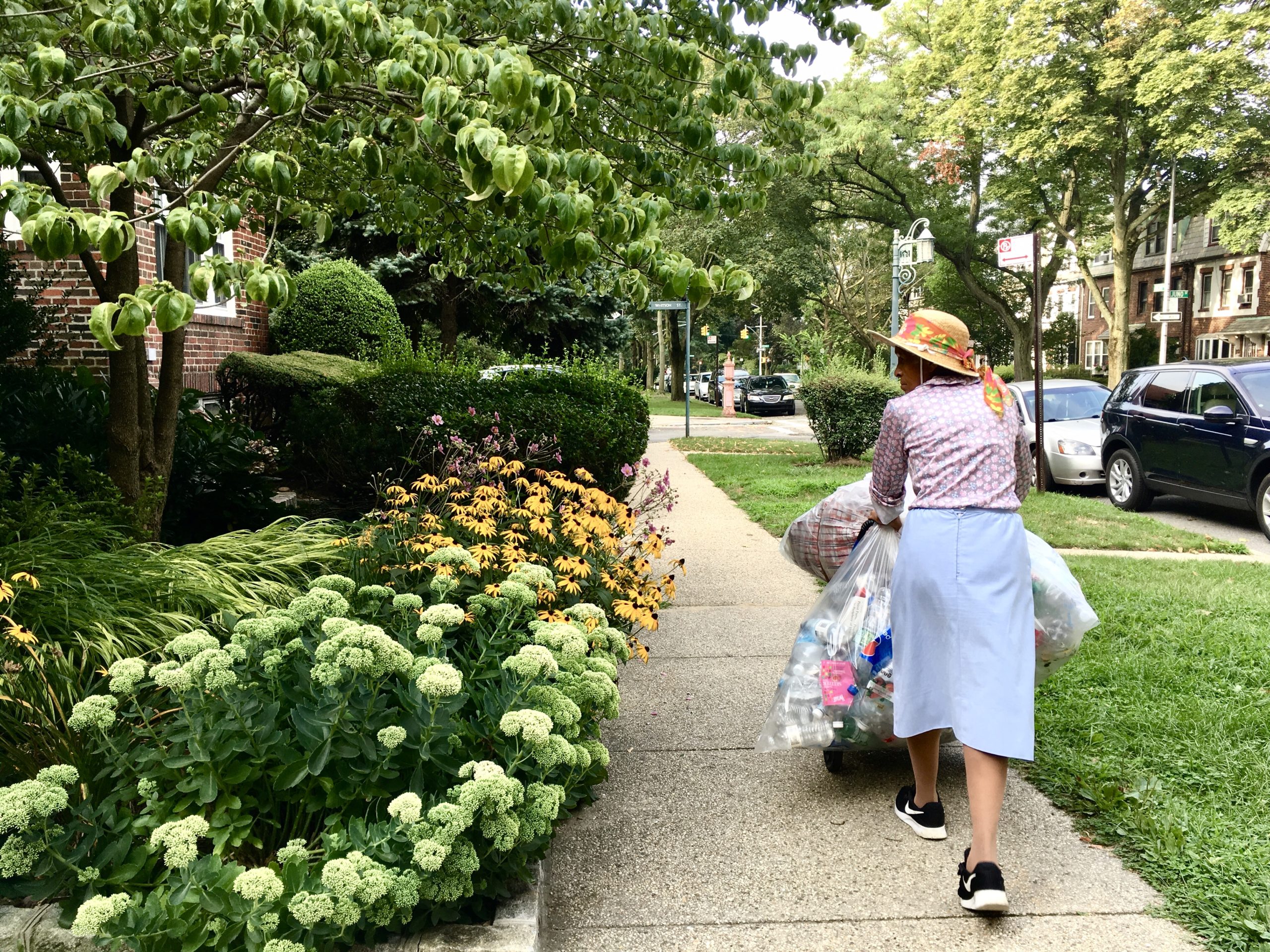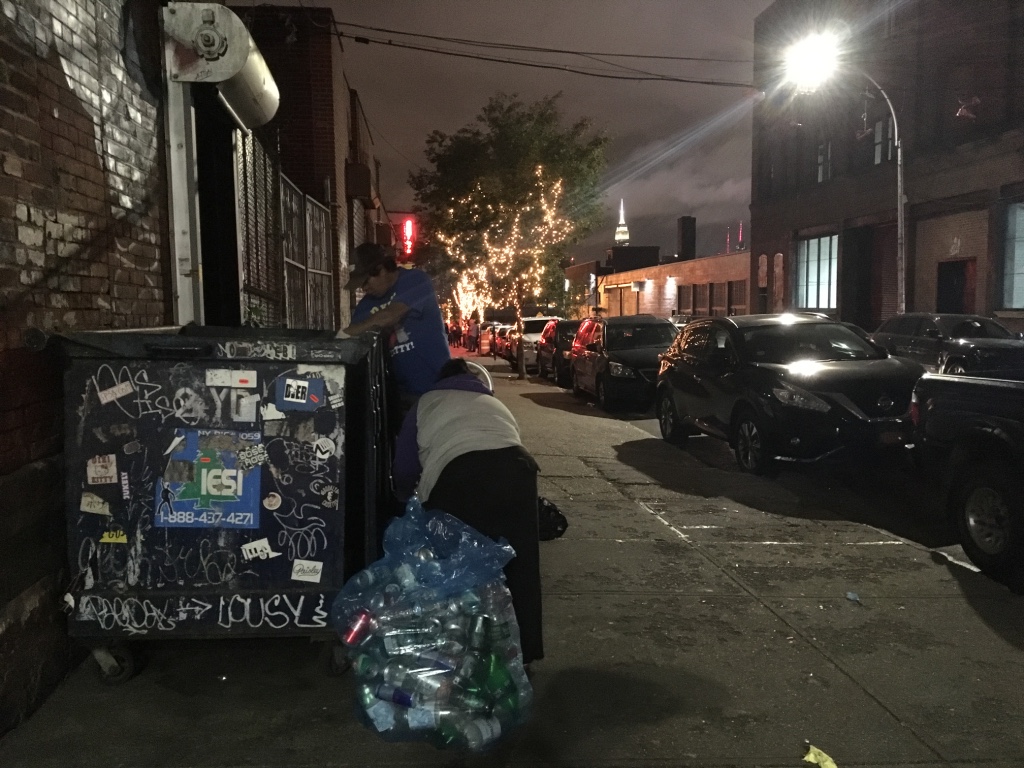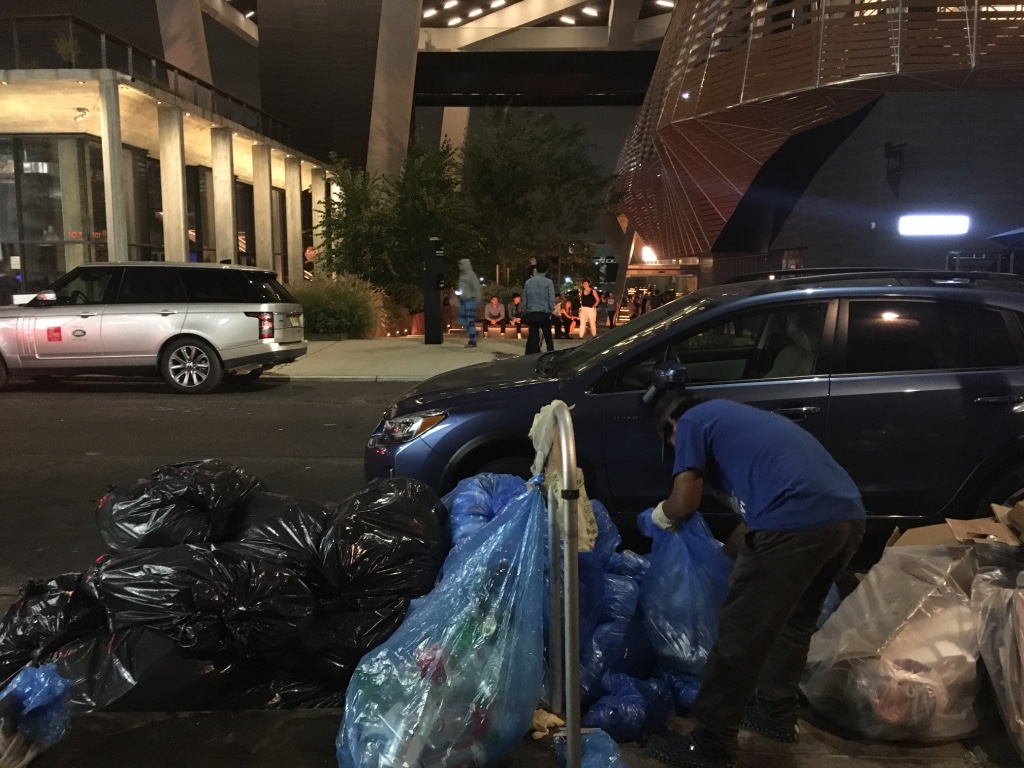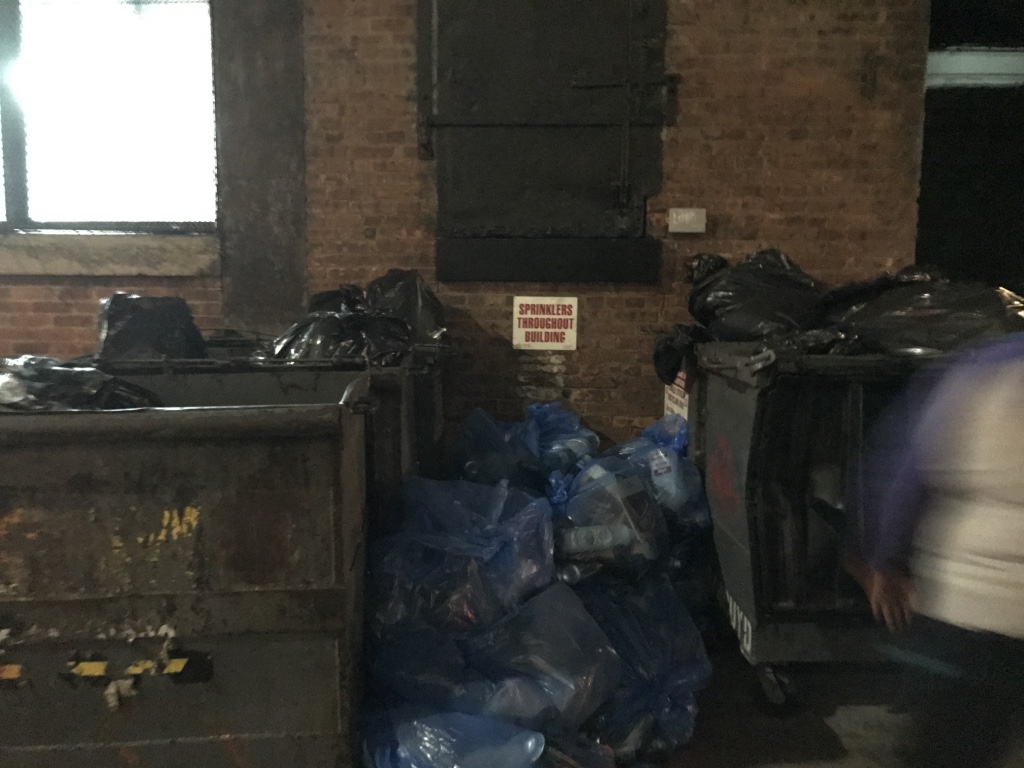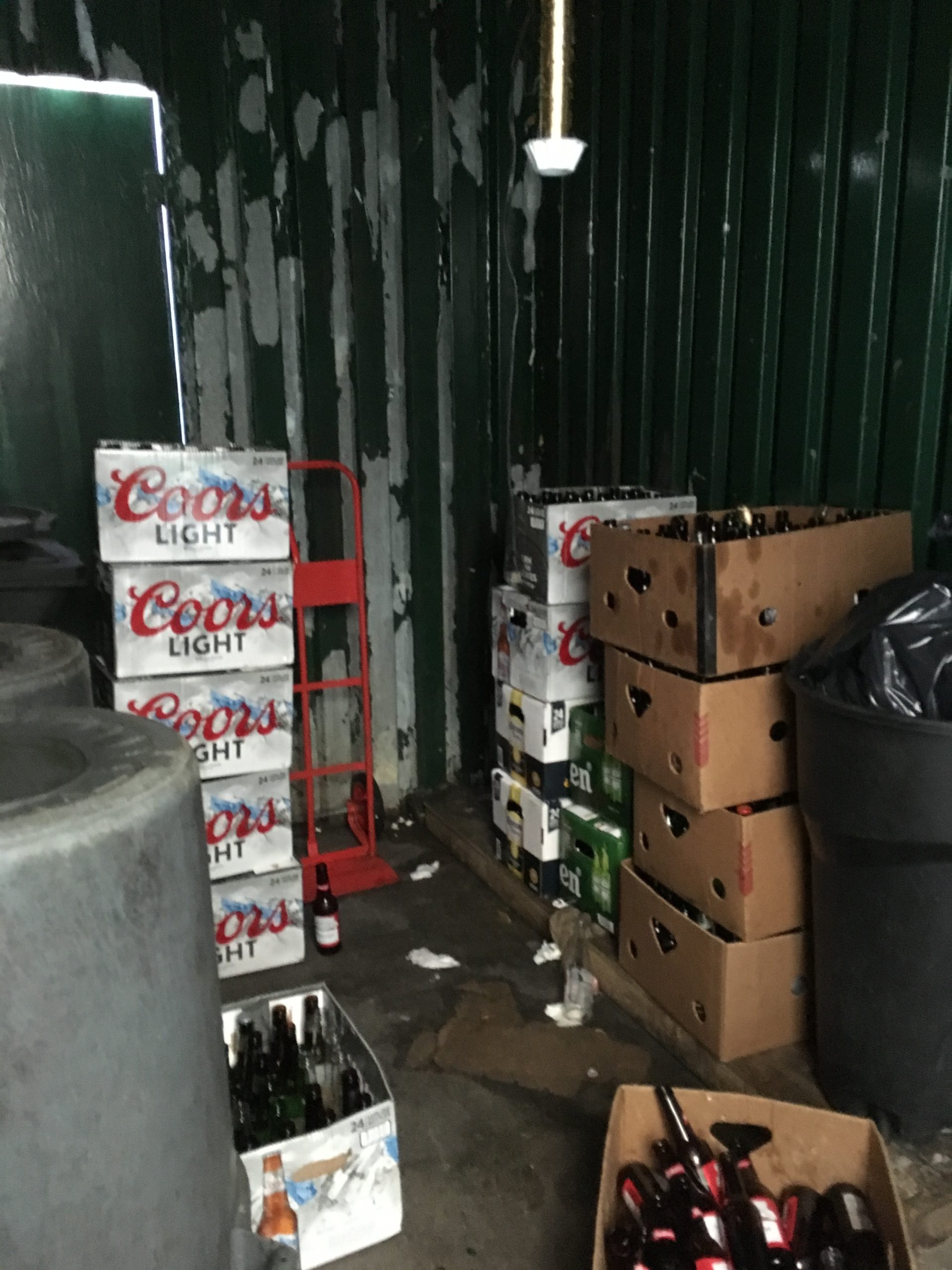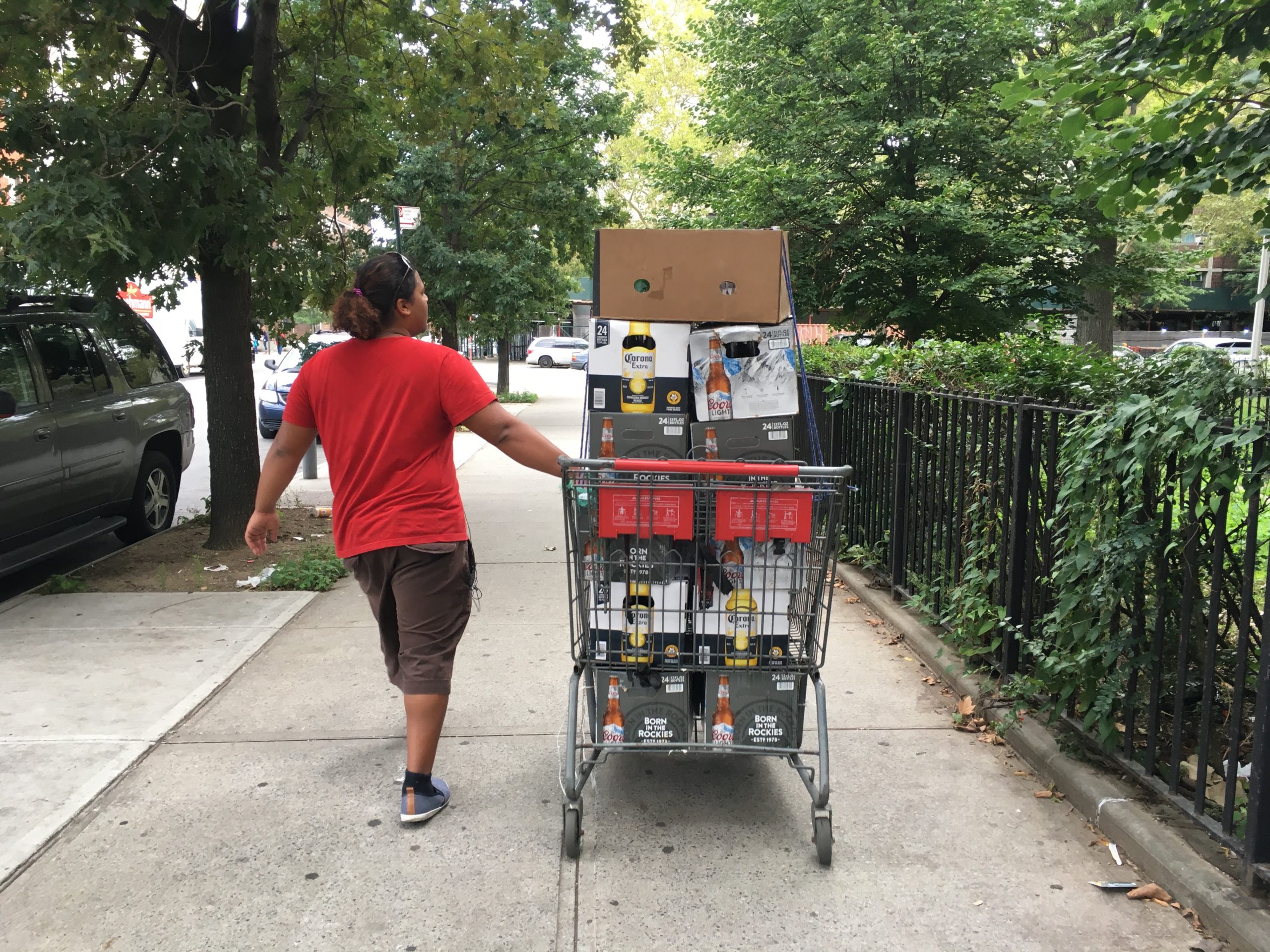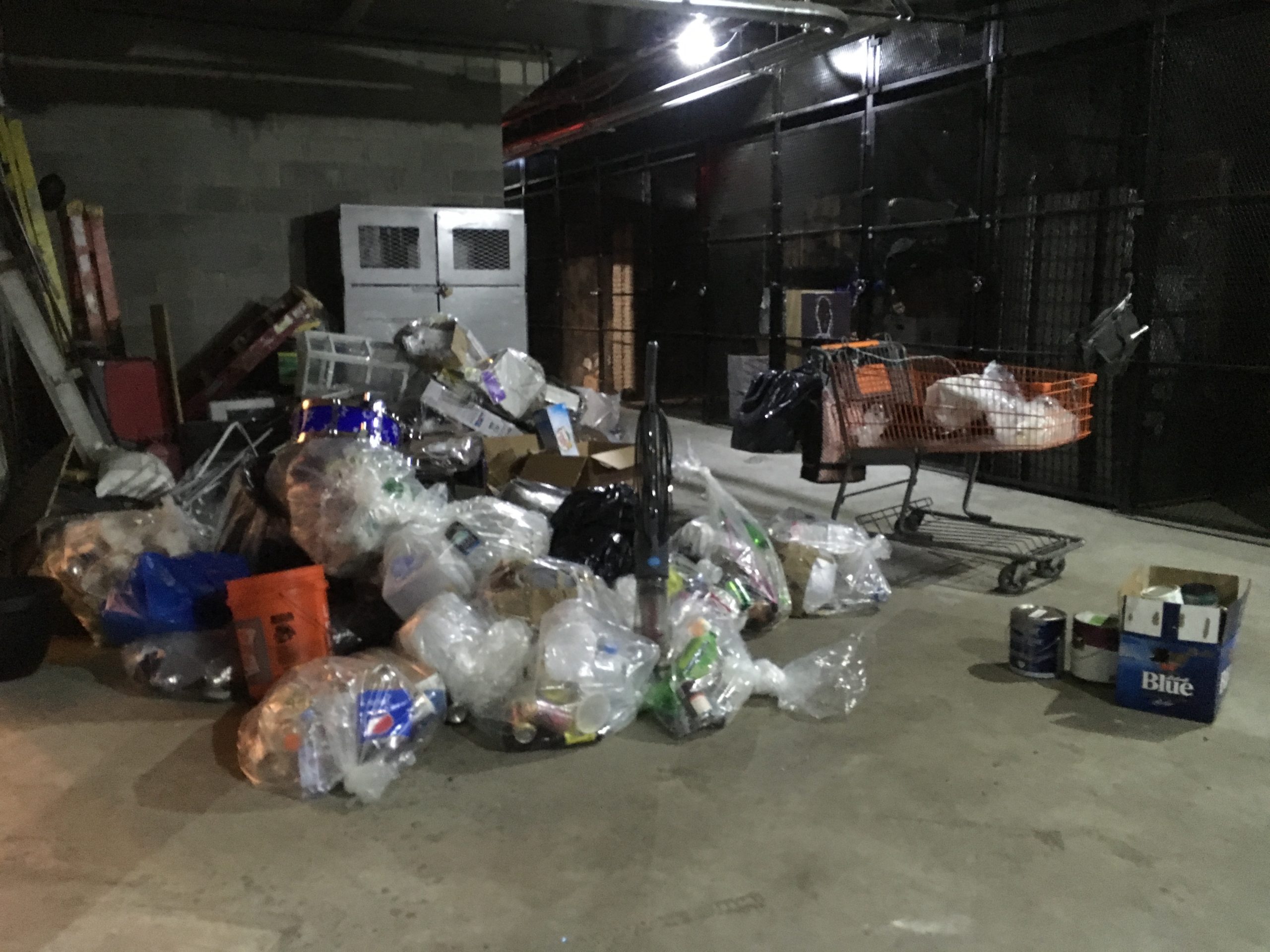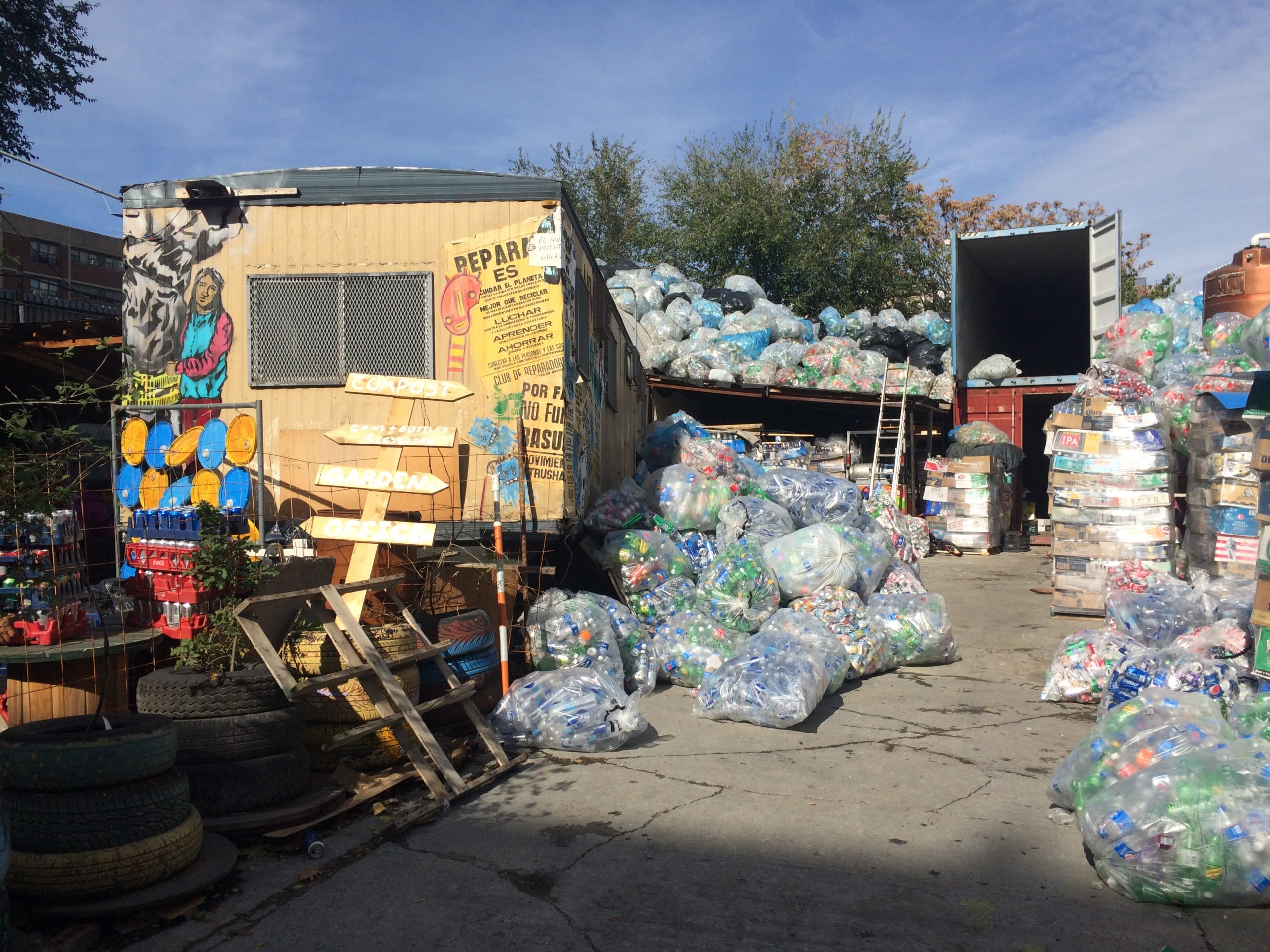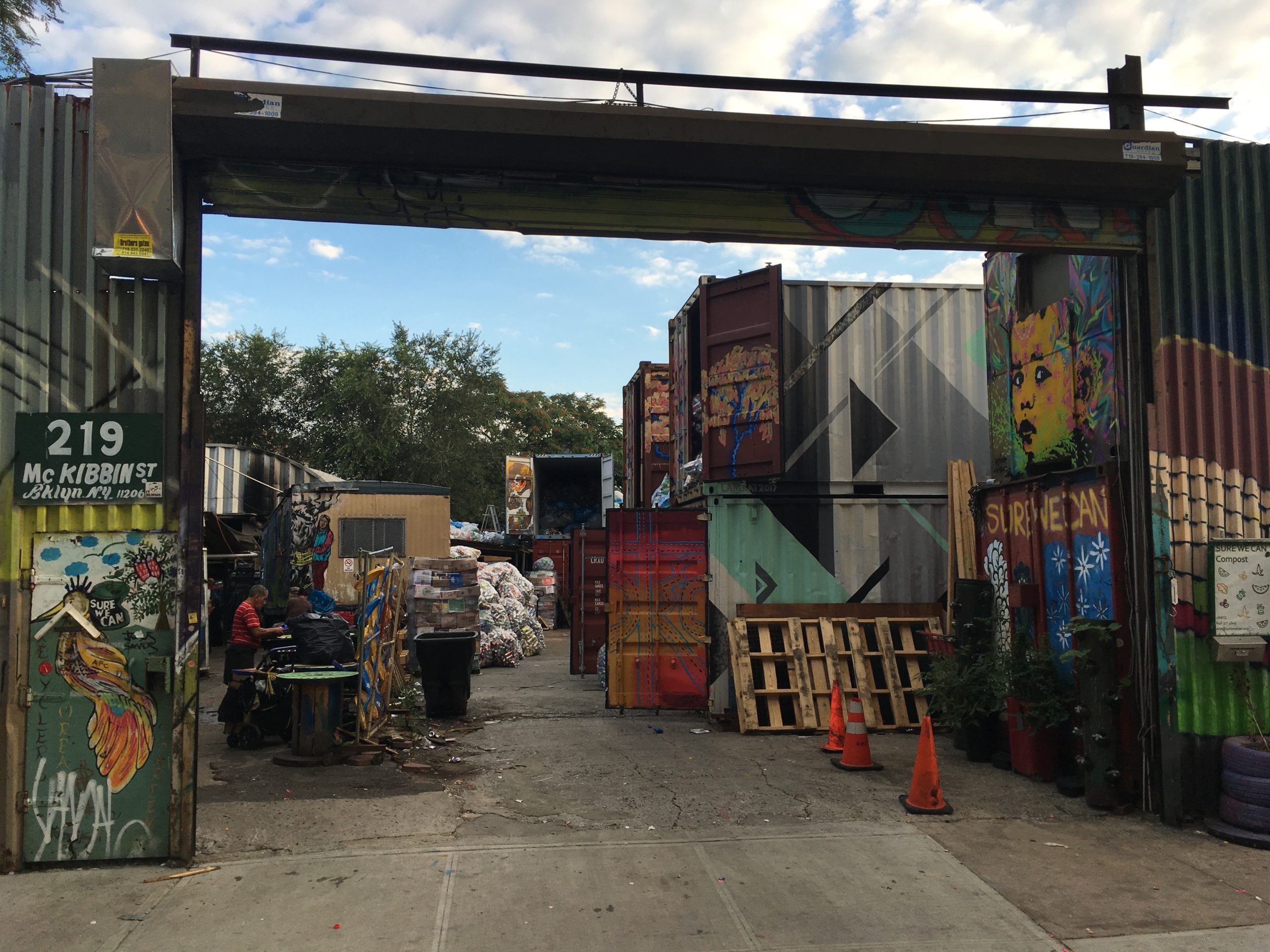
The word “waste” comes from the Latin “vastus,” meaning uninhabited or desolate, similar to the term “vanus,” vacant, empty. Waste is therefore recognized as being useless, negative – i.e., it is the death of places and things, their cadaver. An abandoned building is waste, even if homeless men are using it as a shelter or adventurous children as a place to play. An empty beer bottle is waste, even if it’s perfectly intact.
I spent the past year working with people who make their living picking up bottles and cans on the streets of New York. They call themselves canners or lateros, depending on the language they speak. They push their carts overflowing with waste for miles, day and night, in order to redeem every piece for five cents.
One Saturday evening in early October I followed a Mexican couple in an area in Brooklyn where there is an exceptional number of bars. I waited with them for the last club to close at five in the morning. Then I fell asleep in their car, which they use as temporary storage for their collection while they continued working until dawn.
They both migrated to the US about 30 years ago. They’re in their late forties, they pay rent, have six kids - only one in common, the others with different partners - and two grandchildren. They work seven days a week, whatever the weather, sometimes sleeping not more than four or five hours. They make about $ 40,000 a year, a figure definitely above average among canners. For them the city is an endless treasure trove that’s invisible to most people.
The physical job of picking up cans and bottles makes them think of their work on a farm in the State of Puebla when they were kids. Canners, like farmers, don’t allow themselves to take time off for vacations or sick leave because their land, or turf, has got to be constantly taken care of. It is especially important for canners to establish and care for a geography of places and relationships with people who can give them regular access to the largest amount of recyclables, like those who work in restaurant kitchens or the superintendents of buildings with a significant number of apartments. In order to maintain these relationships, they often carry little gifts such as a piece of “queso” or a box of cookies. The two Mexicans I spent the night with, before working on the street, had a more conventional job – she in a factory, he as a delivery man – but they weren’t earning enough to make ends meet.
What makes canning so compelling to many disadvantaged people is that the amount of money they can make depends on the effort they put into it - and by effort I mean both the hours of work and striving to find new and effective strategies. More importantly, there is no exploitation and no rude bosses to deal with.
Some canners are so into their activity that they become obsessed. This is the case of a jazz musician in his late fifties, raised in the Bronx, and tired of not having a stable income. Since he began canning, he’s in better shape and more in control of his finances. The downside, he says - apart from doing a job that’s harsh and extremely tiring - is that when he goes out on dates, he gets distracted by cans and bottles he sees on the streets, instead of focusing on the woman at his side.
Some people become canners because they feel they have no choice, like those who have lost their job due to an injury, or feel they’re not competitive on the job market because of an addiction. Some, for example, use the street not only as a source of income but also as a place to live. One of the canners I met – a man of an indefinable age, but definitely too young to have only two teeth left – lives in a tent that he moves throughout Brooklyn, camping in vacant lots or work sites; another lives with his ten-year long crack addiction in a trailer put together with sheets of aluminum, parked smack in the center of Bushwick. It looks from the outside like a spaceship out of a cartoon by Hayao Miyazaki. Inside is a bed, several notebooks where he jots down his thoughts, often dedicated to cats or to gods, and a small TV that’s connected to an electric outlet in the parking lot. During the coldest months of winter, he looks for a place in one of the city’s shelters.
The New York of canners focuses on the dark corners of the streets rather than the spires of the skyscrapers. It is a land of the poor, hard-working, and free. Their economy is defined as informal, but in actual fact it takes on very precise shapes, simply not controlled. It takes place in basements, in back lots, on the sides of streets, in vacant lots, in places of no interest to anyone which for this very reason become areas where it’s possible to exercise a form of freedom that is different from the one offered in public spaces devoted to specific uses and activities.

“Freedom is no fear,” Nina Simone sang.
The urbanist Kevin Lynch has offered a powerful analysis of the vital role of a city’s marginal and abandoned spaces. “An ugly, polluted, yet tolerant place [...] these urban remnants are also freer places, where one is momentarily relieved of the pressures of status, power, explicit purpose, and strict control,” Lynch wrote in his last book Wasting Away completed and published posthumously by one of his pupils, Michael Southworth, now Professor emeritus at UC Berkeley College of Environmental Design.[drfn]Kevin Lynch, Wasting Away, ed. Michael Southworth (San Francisco: Sierra Club Books, 1990).[/drfn] In Wasting Away, Lynch reflects on our relationship with the notion of waste and its impact on the city. His basic idea, as Southworth explains in the introduction, is that decline, decadence, and waste are a necessary part of life and growth: we must learn to value these things and manage them well. In order to do so, Lynch maintains, we must reflect on a very simple daily mechanism that concerns all of us. Life is a continual accumulation and disposal: every day we discard things that we believe are useless, we turn them, arbitrarily, into waste which once thrown into some container or hidden corner disappears from view and therefore, as far as we are concerned, no longer exists. And the farther away it is buried the better off we are, because although our existence also depends on waste, we don’t want to have anything to do with it. Those things horrify us in the same way abandoned spaces excite a feeling of fear.
All the canners I worked with spoke about how difficult it was in the beginning to live with that feeling of disgust when digging in other people’s waste; also, the feeling of shame at doing this in public, along with the fear of the streets at the most unthinkable hours and in the darkest corners, especially on the part of the women. One of their biggest challenges is to overcome these feelings, but they eventually do, establishing a new relationship with the city and its waste. A freer one.
They feel that not only is picking up bottles and cans no reason to be ashamed but that it can be something to be proud of. They manage to survive in a city, New York, with one of the highest costs of living in the world, giving things that someone else declared defunct a second life. Canners see these things (I started imagining them with a third eye, like the Spanish illustrator Ricardo Cavolo’s characters), then collect them in the state of placelessness that these things fallen into after being abandoned, and give them a new place. David Koukal, Professor of Philosophy at the University of Detroit Mercy, interprets the placelessness of litter as lack of care: “Litter is that which appears as placeless in a lived world through the lack of care.”
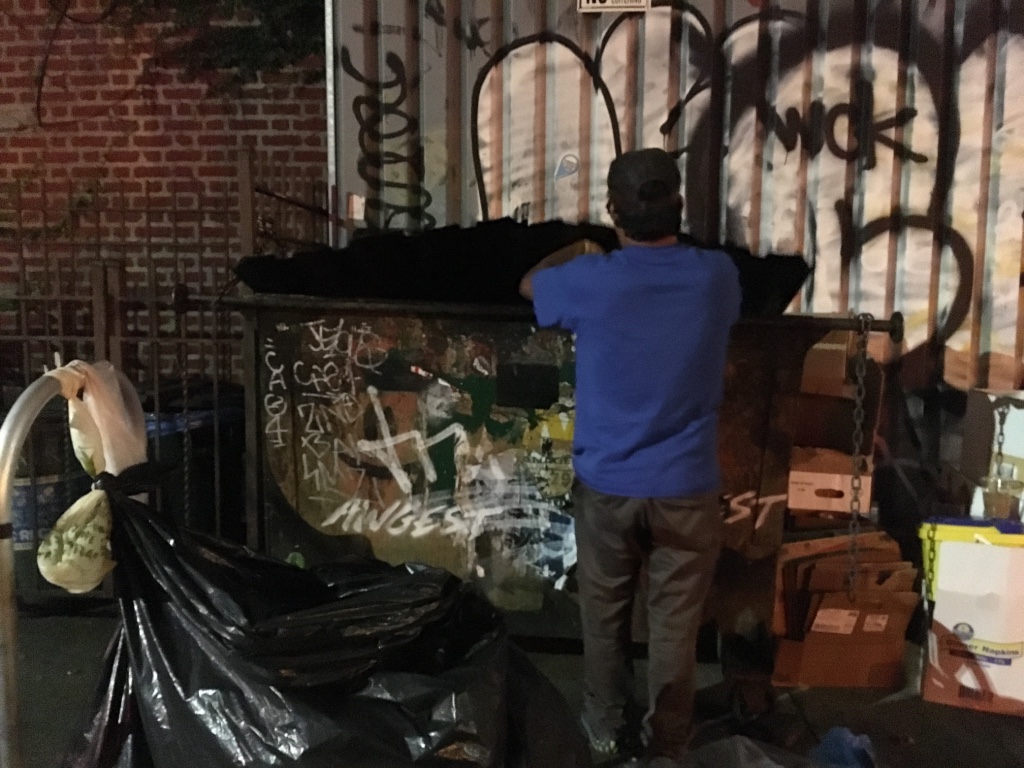
Dai diamanti non nasce niente, dal letame nascono i fior
(From diamonds nothing is born, from manure flowers grow)
Fabrizio De Andrè
Traditionally, waste is hidden, like the dust under the carpets in a house, on a city’s outs Donald Trump would call – has already called – “shitholes.” But more and more we are seeing people who care for the waste even in the heart of the urban context. The activity of canning in Manhattan – just as in the centers of other metropolises – is also made possible by the fact that while cities grow and expand their limits, city centers are transformed, often experiencing periods of abandon. Lynch writes: “Now, as the region continues to expand, wastelands reappear at the city center, in the form of vacant lots, boarded housing, junked cars, and exhausted slums.”[drfn]Ibid, 112.[/drfn] In processes of transformation such as this, nature plays an essential role. Just as soon as a place or an object stops being cared for by dwellers, nature displays its strength, both frightening and reassuring at the same time. Slowly but surely, but with determination, it takes over the abandoned space and lives in, embraces, the ruins, continuing to give them a time (in this sense, the abandoned object is both timeless as well as placeless). The presence of nature, as well as that of the stray and wild animals that roam there, reminds us that the classifications and dichotomies we use to qualify the objects and the spaces we live in – useful/useless, lived in/abandoned, active/dead – are a mental constriction that denies, according to Lynch, “continuous flow and gradation.”[drfn]Ibid, 40.[/drfn] This is one of the reasons why cities with a significant presence of uncultivated green spaces – as in the case of Detroit – can look so attractive to outsiders. The time of nature growing in and occupying urban spaces without permission creates a feeling of calm but also of vital tension. It represents a challenge, a form of resistance to the mainstream narrative that synthesizes the life of a post-industrial city in phases – an extraordinary rise, a tragic decline, and then a controversial rebirth – set in motion by tragedies or other upturns that, depending on how they are defined, tell different stories.
The presence of spontaneous nature wakes us up to the fact that Detroit wasn’t born with the automobile factories. It has always been there. It never died. It wasn’t born again ten years ago. Its so-called abandoned spaces have always been used in one way or another or traversed by someone. By a group of kids for play, by a homeless person for sleeping, or by an artist for creating.
In Detroit the artist Scott Hocking built his practice on ruins. His work is a non-sacred monument not only to abandoned places and objects, or those that have never been used, but to forgotten time as well - what is always flowing, every day, at the same speed, initiating processes of change, and which simply continues. Scott’s biography itself shows that his relationship with waste spaces and objects did not begin with his deliberate work as an artist, for in his childhood, Scott, too, was a canner. Here he is in his own words:
At some point around 10 years old - or perhaps I was 9 or 11 - I became obsessed with collecting returnable cans and bottles for money. I'd call it my first paying job. My father, a poor-man's jack of all trades, would use me as his assistant on plenty of mechanical and carpentry jobs, but I don't remember ever seeing a dime. He would drink quart-sized glass bottles of Mountain Dew, a lime-flavored soda packed with caffeine, which they sold in cartons of 8 at the time. He also had a complete upper set of false teeth, so I guess drinking quarts of sugar-water didn't harm him much. Pop bottles were everywhere when I was a kid, and big glass bottles of soda and beer[s] were easy to find. Probably my first act of “collecting” was bottle caps: I would find the metal caps of bottled sodas on the ground, and if it was a brand I didn't have yet, I'd add it to my collection - which was a wooden board with dozens of bottle caps nailed to it. I remember pounding nails right through the center of the caps, kind of ruining the logo of that brand, but that must not have been my childhood priority. Collecting caps led to collecting whole bottles, with their individual glass shapes and styles. But money must have entered my mind eventually, because, just like those 8-packs of Mountain Dew we racked up and returned for cash, I started to see all the discarded bottles and cans laying around town as dollar signs. I can still remember the rush of finding a big stash of “empties.” Michigan has a 10¢ deposit for returnables, so it didn't take long to recover 1 dollar, maybe even 5 dollars in empties - that's a lot of cash for a kid back then! I would ride around the neighborhood on my BMX, looking in ditches, trash cans, dumpsters, wherever. Plastic grocery bags would hang from my handlebars as I rode around, and sometimes I'd collect more plastic bags out of the trash if I needed them. Sugary drink cans and bottles were often covered in ants in some trash can, and empty beers had that stale beer smell, something I got used to years before ever drinking one. I'd shake everything out before putting them in my plastic bags, but those bags were sticky as hell and smelled disgusting by the end. At the height of my empty-collecting obsession, I asked my stepmother to wake me up at dawn everyday, so that I could get on my bike and beat all the old retired men to the spoils - my only real competitors. Along with becoming my first habitual collecting, gathering empties also led to my first theft: I was riding on the hunt for bottles, when I saw a few 6-packs of empties in a garage - I circled around and looked for any witnesses, before snagging a few of the beer bottles out of the cartons. I never really did this kind of thing again - felt too guilty I guess - but a year or so later, when I'd gotten older and more brazen in my illegal activities, I concocted a more elaborate plan to capitalize on empties: Sneak out of my home in the middle of the night, hike down the railroad at the end of my street and hop the fence behind the 7-Up soda bottling plant, remove 3 large, clear plastic bags full of already-returned 7-Up brand empty cans and plastic bottles that sat in giant dumpsters, and throw them back over the fence. I remember hauling them back to my garage in the wee hours, and surveying how much money in ten-cent ant-covered cans I'd acquired. Sadly, when I brought them to the liquor store the next day, the clerk recognized the giant clear plastic bags and knew they had been stolen - a problem I wouldn't have had with today’s self-service can-crushing machines. My empty collecting slowed down as I got older, but I'd still do it for extra cash now and then. Even when I was broke while in college, I would occasionally walk around the campus at night, collecting all the empties. And one of my earliest art installations was a piece where I walked about Detroit, collecting empty liquor bottles - which were everywhere, because unlike soda and beer, liquor containers had no deposit, no value. I collected thousands of liquor bottles for that project - not nearly as profitable as my BMX bagging days, but my hands ended up just as dirty and disgusting, ha...
